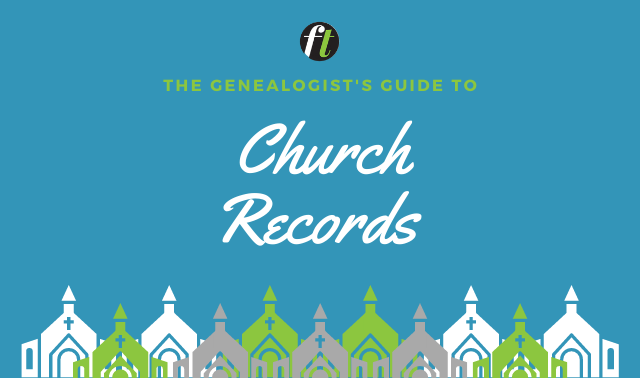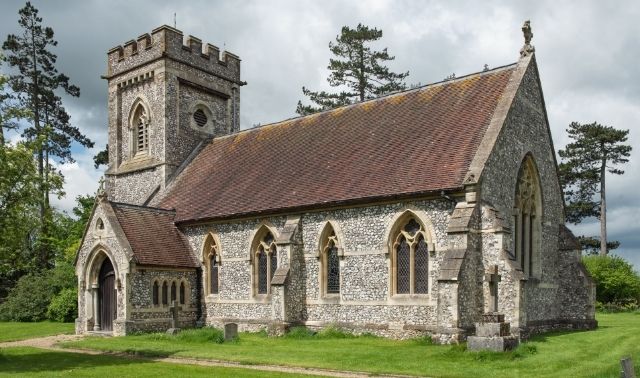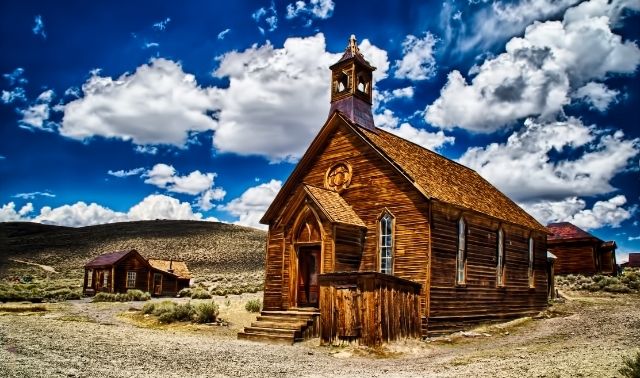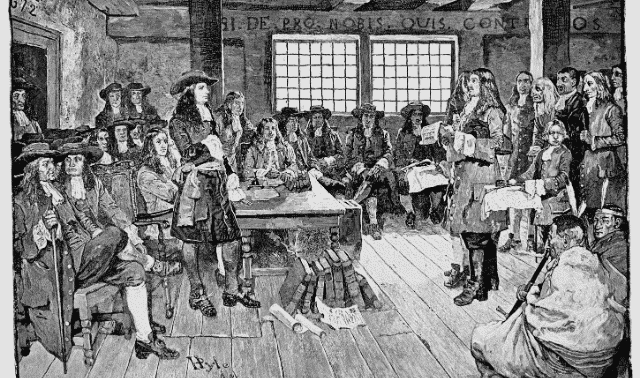Sign up for the Family Tree Newsletter! Plus, you’ll receive our 10 Essential Genealogy Research Forms PDF as a special thank you.
Get Your Free Genealogy Forms
"*" indicates required fields
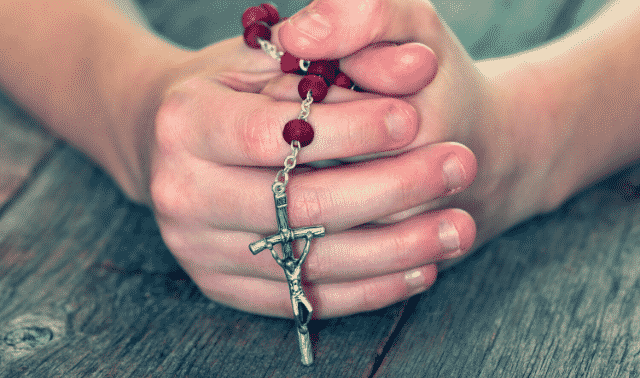
A billion Catholics live in the world today: Theirs is the largest Christian faith, with a nearly 2,000-year history. If you’ve got Catholics on your family tree, consider it a genealogical grace. Catholic records are arguably the most extensive in the world, and can be a proverbial stained-glass window into the lives of your ancestors.
A History of Catholicism in Europe and the United States
Early missionaries spread Christianity along Mediterranean shores. By 380, the Roman Empire officially became Catholic. The faith swept Europe during the Middle Ages. Sixteenth- and seventeenth-century Protestant offshoots notwithstanding, Catholicism expanded with European empires to North and South America.
Cross-carrying settlers raised chapels in the future United States long before New England Protestants built their meetinghouses. Spanish missions were active in Florida and New Mexico in the 1500s and 1600s, and into the 1700s in California and Texas. In the late 17th and early 18th centuries, French Catholics descended from Canada to Louisiana Territory, populating parts of what’s now Michigan, Illinois and Arkansas on the way to New Orleans.
In the Protestant-leaning British Colonies, the only Catholic diocese before 1800 was in Baltimore, Md.—a colony founded as a haven for English Catholics. The diocese of Mexico (established in 1530) then included today’s American Southwest. The dioceses of Quebec (1674) and eventually New Orleans (1793) ran New France. The United States gained its first significant Catholic population with the Louisiana Purchase in 1803, and later with Western land acquisitions.
The mid-1800s saw the start of widespread Catholic immigration. The Irish fled potato famines for northeastern US cities and inland jobs. Italians landed in Boston, New York, Philadelphia, Chicago, Baltimore and San Francisco. Southern and western Germans, Poles, Slovaks, Slovenes, Hungarians and other Eastern Europeans flocked to the farmlands and mines of Pennsylvania. Basque Catholics came to Boise, Idaho.
By 1924, laws slowed immigration. In the later 1900s, Hispanic Catholics arrived along with those from Vietnam, India, Iraq and Lebanon. Northeastern and southwestern states now have the highest percentages of Catholics; the Southeast and Utah have the lowest. Mid-US states such as Texas, Illinois, Louisiana, the Dakotas, Wisconsin, Nebraska and Minnesota are one-quarter to one-third Catholic. Today, the Catholic Church claims about 74 million members in the United States.
What Records the Catholic Church Keeps
The Roman Catholic Church encompasses several autonomous churches under the banner of Rome. The Latin rite dominates in the United States, but several Eastern churches are represented as well, including Orthodox, Byzantine, Maronite and Syriac.
Church governments are generally organized into regional dioceses (Latin) or eparchies (Eastern), which are in turn made up of congregations or parishes. Groups of dioceses form archdioceses. Records of individual members, which may be certificates and/or registers, are created at the parish level. They may stay there, or over time might migrate to another church, or diocesan or archdiocesan archives. Religious orders, though affiliated with the church, often have separate administrative structures.
Sacramental records celebrate religious milestones of Catholic life. They also can be the salvation of genealogists looking for their Catholic relatives. Godparents or sponsors named in them may be relatives or close friends. Look for photos commemorating these events among family sources:
- Baptism: Infant baptismal records can include the child’s full name, birth date and baptismal date, parents’ and sponsors’ names, and an indication if the birth happened out of wedlock (“illegitimus”). Sometimes the baptized child’s marriage data is added later (even if the marriage took place in another parish).
- First Communion and confirmation: These sacraments are celebrated at age 7 and 12 or 13, respectively, in the Latin church, and in infancy in many Eastern Catholic churches. Participation indicates a family was affiliated with the parish and wanted to raise the child in the faith. Because a class would often receive the sacrament together, parish records may contain group photos.
- Marriage: These records may include names of the couple and their parents (including the bride’s maiden name), date, witnesses and home parish, if other than the one where the marriage took place.
- Death: You may find multiple types of death records. A record of a Mass of Christian Burial, a service performed in the deceased’s honor, will likely contain a name, age at death, death/burial date, and occasionally other details. If the person was interred in a Catholic cemetery, a burial record may also exist at the parish or diocese or at an administrative office for the cemetery.
- Holy Orders: If your ancestor was a priest or permanent deacon (i.e., deacons who could be married), he received this sacrament. Multiple religious orders exist, and each keeps its own records about members’ lives of service. Some orders also publish biographical sketches, which may mention an Old World hometown and other details. This record may appear in diocesan sources or in records kept by the religious order.
Finding Catholic Records
To locate Catholic parish records, you’ll need to determine what parish your ancestors worshiped at using sources such as family Bibles, obituaries, cemetery records, funeral cards, marriage announcements, church bulletins and other memorabilia.
If these don’t offer clues, identify parishes located near your family’s address using web searches, city directories, censuses or property records. Look for ethnic parishes nearby, as well. From 1817 in the United States, the annual Official Catholic Directory lists active parishes and diocesan boundaries.
Contact existing parish offices for old sacramental records. Locate Latin rite parish offices via this database or the current Official Catholic Directory. For Eastern Orthodox parishes, examine this list.
Contact the parish office to ask where records are kept for the period covering your ancestor’s membership there. Records from a defunct parish may be with a parish it merged with.
One exception to the church’s organizational structure is the Archdiocese for the Military Services, USA. Baptisms on American military bases or installations are recorded here, as well as later sacraments for that person. Records for marriages performed on bases are sent back to the home parish. You can request records (they go back to 1917) with a form on the Archdiocese’s website; click on Offices, then Sacramental Records Form.
If a parish has passed along its older records, contact the diocesan or archdiocesan archives. US Catholic Sources: A Diocesan Research Guide by Virginia Humling (Ancestry) has descriptions of dioceses and their archives. Many of these archives also have excellent websites; search for the name of the diocese plus the word archive. Diocesan boundaries change over time; the Official Catholic Directory can help you track those boundaries and church archivists can help you determine where records are today. Likewise, you can find a list of eparchies here.
Remember that the church’s primary purpose is ministry, not genealogy. Keep requests limited and specific, include all known information and a donation to the church, and be polite and patient. You may not get direct access to sacramental records, which are considered private. Staff likely will copy or transcribe records before 1930; request a photocopy of the record rather than an abstract.
Catholic Parish Records
Local parishes, especially ethnic ones, offered an active social life and often parochial education. Religious orders ran hospitals and orphanages. Their records can tell you a lot about your ancestors’ lives.
- Parish histories: Often published for 50- or 100-year church anniversaries, these could contain history, membership or donor lists, group photos, school information, lists of priests and social events. Find them at parish offices or diocesan and Catholic university archives. The American Catholic Historical Society has more than 1,300 parish histories in its collection at the Philadelphia Archdiocesan Historical Research Center (PAHRC). Find a directory to nearly 4,000 parish histories at the University of Notre Dame.
- School records: Look for these in school (if still operating) and parish offices, diocesan archives and other regional repositories. Though student files may be hard to come by, archives may have class photos, school histories, news clippings and other memorabilia. Search for Catholic school yearbooks at sites such as E-Yearbook.com and Old-Yearbooks.com.
- Other institutional records: Did your ancestor stay in a Catholic-run hospital, asylum or orphanage? Contact the facility (if it still exists), administrative offices of the sponsoring order, or the diocesan or other regional archives for records. Run a Google search with the name of the facility, town and a descriptor such as orphanage.
- Newspapers: Diocesan and archdiocesan newspapers date to the early 1800s. The Catholic Miscellany (Charleston, S.C.) ran from 1822 to 1861 and was revived in 1990; The Pilot (Boston) has published continually since 1829. Catholic papers rarely appear in major online newspaper collections. Check with dioceses to see whether they keep old newspapers, as Denver does (the Denver Catholic Register is searchable here). PAHRC and UND maintain large newspaper collections; check with regional archives, too. Another resource worth checking for your ancestor is the annual Records of the American Catholic Historical Society (1886 to 1920), indexed and available at many genealogical and Catholic university libraries. You can browse several digitized volumes from Villanova University’s website. Several volumes also appear at Internet Archive and its Open Library.
Catholic Records on FamilySearch
Use the Family History Library online catalog to see what records the library has for your ancestors’ parish. Run a place search for the county or town and click on Church Records.
More Resources
Websites
- Catholic Internet Directory
- CatholicLink.org: Archives, Libraries
- Local Catholic Church and Family History Genealogical Research Guide
Publications
- The Official Catholic Directory (P.J. Kenedy & Sons)
- Records of the American Catholic Historical Society (ACHA annual, 1886–1920)
- Records of the Roman Catholic Church in the United States by Cora C. Curry (National Genealogical Society)
- US Catholic Sources: A Diocesan Research Guide by Virginia Humling (Ancestry)
Organizations and Archives
- American Catholic Historical Society
- Philadelphia Archdiocesan Historical Research Center
- University of Notre Dame Archives
A version of this article appeared in the March/April 2012 issue of Family Tree Magazine.

